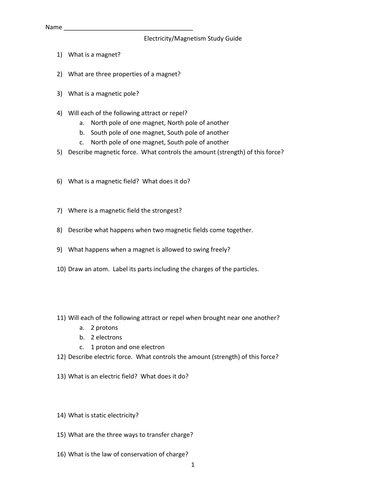

Study guide for Electricity and Magnetism Unit Review or Final Exam practice. Includes FULL answer key! Study guide is 6 pages and answer key is 6 pages.
Standards addressed:
5. Electromagnetism
Central Concept: Stationary and moving charged particles result in the phenomena known as electricity and magnetism.
5.1 Recognize that an electric charge tends to be static on insulators and can move on and in conductors. Explain that energy can produce a separation of charges.
5.2 Develop qualitative and quantitative understandings of current, voltage, resistance, and the connections among them (Ohm’s law).
5.3 Analyze simple arrangements of electrical components in both series and parallel circuits. Recognize symbols and understand the functions of common circuit elements (battery, connecting wire, switch, fuse, resistance) in a schematic diagram.
5.4 Describe conceptually the attractive or repulsive forces between objects relative to their charges and the distance between them (Coulomb’s law).
5.5 Explain how electric current is a flow of charge caused by a potential difference (voltage), and how power is equal to current multiplied by voltage.
5.6 Recognize that moving electric charges produce magnetic forces and moving magnets produce electric forces. Recognize that the interplay of electric and magnetic forces is the basis for electric motors, generators, and other technologies.
Standards addressed:
5. Electromagnetism
Central Concept: Stationary and moving charged particles result in the phenomena known as electricity and magnetism.
5.1 Recognize that an electric charge tends to be static on insulators and can move on and in conductors. Explain that energy can produce a separation of charges.
5.2 Develop qualitative and quantitative understandings of current, voltage, resistance, and the connections among them (Ohm’s law).
5.3 Analyze simple arrangements of electrical components in both series and parallel circuits. Recognize symbols and understand the functions of common circuit elements (battery, connecting wire, switch, fuse, resistance) in a schematic diagram.
5.4 Describe conceptually the attractive or repulsive forces between objects relative to their charges and the distance between them (Coulomb’s law).
5.5 Explain how electric current is a flow of charge caused by a potential difference (voltage), and how power is equal to current multiplied by voltage.
5.6 Recognize that moving electric charges produce magnetic forces and moving magnets produce electric forces. Recognize that the interplay of electric and magnetic forces is the basis for electric motors, generators, and other technologies.
Something went wrong, please try again later.
This resource hasn't been reviewed yet
To ensure quality for our reviews, only customers who have purchased this resource can review it
Report this resourceto let us know if it violates our terms and conditions.
Our customer service team will review your report and will be in touch.
$3.50
